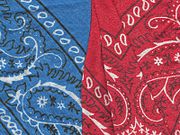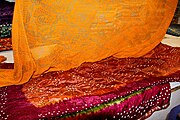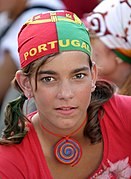Kerchief

A kerchief (from the Old French couvre-chef, "cover head"), also known as a bandana or bandanna, is a triangular or square piece of cloth tied around the head, face, or neck for protective or decorative purposes. The popularity of head kerchiefs may vary by culture or religion, often being used as a Christian headcovering by men and women of the Anabaptist, Eastern Orthodox, and Plymouth Brethren denominations,[1] as well as by some Orthodox Jewish and Muslim men and women and is also considered a hat.
The neckerchief and handkerchief are related items.
Types
[edit]Bandana
[edit]
A bandana or bandanna (from Hindi and Urdu, ultimately from Sanskrit बन्धन or bandhana, "a bond")[2] is a type of large, usually colourful kerchief, originating from the Indian subcontinent, often worn on the head or around the neck of a person. Bandanas are frequently printed in a paisley pattern and are most often used to hold hair back, either as a fashionable head accessory or for practical purposes. It is also used to tie around the neck to prevent sunburn, and around the mouth and nose to protect from dust inhalation or to hide the identity of its wearer.
The word bandana stems from the Hindi words 'bāndhnū,' or "tie-dyeing," and 'bāndhnā,' "to tie." These stem from Sanskrit roots 'badhnāti,' "he ties," and Sanskrit 'bandhana' (बन्धन), "a bond."[3] In the 18th and 19th centuries bandanas were frequently known as bandannoes.[4]
Bandanas originated in India as bright-coloured handkerchiefs of silk and cotton with spots in white on coloured grounds, chiefly red and blue Bandhani. The silk styles were made of the finest-quality yarns and were popular. Bandana prints for clothing were first produced in Glasgow from cotton yarns, and are now made in many qualities. The term, at present, generally means a fabric in printed styles, whether silk, silk and cotton, or all cotton.[5]
The bandana found popularity in the US during the late 1700s because snuff users preferred coloured and patterned silk handkerchiefs over white ones, as the former hid tobacco stains better when the users blew their noses. In the late 18th and early 19th centuries, bandanas began to appear with political and military advertisements printed on them.[citation needed] Such printed bandanas were common in the early and mid-1900s during World War I and World War II. Decorative bandanas were also common gear, particularly as neckwear, for cowboys, and so for country and western entertainers such as Roy Rogers and, later, Willie Nelson.[6] The latter singer began wearing bandanas when he moved from Nashville back to Austin, Texas, "just in time to catch the hippie wave cresting at counterculture center the Armadillo World Headquarters."[7]
Around the same time, bandanas also became popular with motorcyclists, particularly with Harley-Davidson riders and bikers.[citation needed] In the 1970s paisley bandanas also became popular amongst gangs in California, most notably with two well-known rival gangs, the Bloods, who wore red bandanas, and the Crips, who wore blue ones.[8]
Green bandanas have become a symbol of the abortion-rights movement.[9]
Oramal
[edit]
The Oramal is a traditional kerchief used in Central Asia and the Caucasus (note how it is tied, the neck is usually not covered by it). In some countries like Uzbekistan, it was traditionally used only at home, while in public the paranja was more popular. In other countries, like Kazakhstan, it was commonly used in public. In Kyrgyzstan, the white color is an indication that the woman is married.
As well it was widely used by men at horse riding in summertime instead of wearing a cap.
Austronesian headscarves
[edit]Kerchiefs are also worn as headdresses by Austronesian cultures in maritime Southeast Asia. Among Malay men it is known as tengkolok and is worn during traditional occasions, such as weddings (worn by the groom) and the pesilat.
See also
[edit]|
Other neckwear: |
Other headwear
|
References
[edit]- ^ Hume, Lynne (24 October 2013). The Religious Life of Dress: Global Fashion and Faith. Bloomsbury Publishing. ISBN 978-0-85785-363-9.
Following the general Anabaptist worldview, Hutterite dress not only emphasizes modesty but also separation from the world. ... The women wear ankle-length skirts or dresses with a blouse, a kerchief-style head covering with polka dots (tiechle), usually black and white, and solid comfortable shoes.
- ^ "Definition of bandanna". Merriam-webster.com. 2012-08-31. Retrieved 2013-03-15.
- ^ "Bandanna from Dictionary.com". Dictionary.reference.com. Retrieved 2017-06-10.
- ^ Yule and Burnell (2013), "Bandanna", p.78.
- ^ Curtis, H. P. (1921). Glossary of Textile Terms. Marsden & Co. Ltd.
- ^ Hilgers, Laura (November 2020). "The Global History of the Bandana". Smithsonian Magazine. Retrieved 14 March 2024.
- ^ "Nine-Things-You-Didnt-Know-About-Willie-Nelson". 6 June 2012. Retrieved 2021-01-19.
- ^ "Ethnic Dress in the United States: A Cultural Encyclopedia2016 010 Edited by Annette Lynch and Mitchell D.Strauss Ethnic Dress in the United States: A Cultural Encyclopedia Lanham, MD Rowman & Littlefield 2015 x + 326 pp. 9780759121485(print) 9780759121508(e-book) £49.95 $75". Reference Reviews. 30 (1): 17. 2016-01-18. doi:10.1108/rr-09-2015-0225. ISSN 0950-4125.
- ^ "How the green bandanna became a symbol of the abortion rights movement". The Seattle Times. 2022-07-07. Retrieved 2023-06-19.
- Additional sources
- Hilger, Laura (November 2020). "The Global History of the Bandana". Smithsonian Magazine.
- Yule, Henry, & A.C. Burnell (2013). Hobson-Jobson: The Definitive Glossary of British India. (Oxford, England: OUP). ISBN 9780191645839.





